Topic area
Human and Economic
Geography
Sub-topic area
Economic activities
Key unit competence
By the end of this unit, you should be able
to investigate impact of forests and forestry
on sustainable development in Rwanda.
Unit objectivesBy the end of the unit, you should be able to:
• Define forest and forestry.
• Identify the major forested areas of
Rwanda.
• List the factors influencing forest
exploitation.
• State different methods of lumbering
in Rwanda.
• Give the importance of forests and
forestry in Rwanda.
• Outline the products of lumbering in
Rwanda.
• Identify the problems affecting forest
exploitation in Rwanda.
• State the causes and effects of
deforestation in Rwanda.
• State the measures for forest
conservation in Rwanda.
Forest and forestry
Activity 12.1
Study the photograph shown below and
answer the questions that follow.

A forest is a group of trees growing together
either naturally or artificially in a given
area. It can also be defined as an area
covered majorly by a variety of trees
and undergrowth. There are natural and
artificial forests. Natural forests grow on
their own, while artificial forests are planted
by humans.
Forestry is the science or practice of
planting, managing, and caring for forests.
It involves conservation and scientific
management of forests where exploitation
and conservation are balanced to ensure
sustainability.
Rwanda has 660,351 hectares of forested
area. This accounts for 25% of the country’s
total land area. There are about 257,500
hectares of protected natural forests and
approximately 402,851 hectares of artificial
forests.
Forestry contributes to only about 0.6 %
of the country’s Gross Domestic Product
(GDP) according to MINAGRI 1998. The high
demand for wood and timber in Rwanda
is supplemented by imported wood from
Democratic Republic of Congo
here are forested areas that are under
conservation. They include the following:
• Akagera National Park
• Nyungwe National Park
• Birunga/Volcanoes National Park
• Gishwati Forest
• Mukura Forest
• Gallery Forest of Eastern Province
The major forested areas in Rwanda and their characteristics
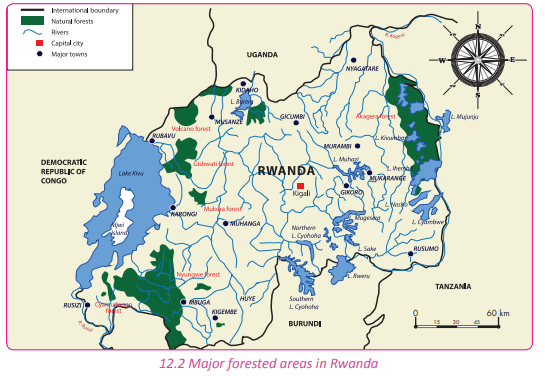 Activity 12. 2
Activity 12. 2
Work in pairs.
1. Name areas in Rwanda where forests
are found.
2. Classify the forests into either natural
or artificial.
3. Describe the characteristics of the
forests you have identified.
4. Discuss the importance of the forests
to Rwanda.
5. Give reasons why it is necessary to
conserve them.
6. Write down your findings and present
them in a class discussion.
Forests in Rwanda are grouped into two:
(a) Natural forests
The following are examples of such forests
in Rwanda:
(a) Nyungwe Forest
(b) Gishwati Forest
(c) Mukura Forest
(d) Cyamudongo forest
(e) Birunga Forest
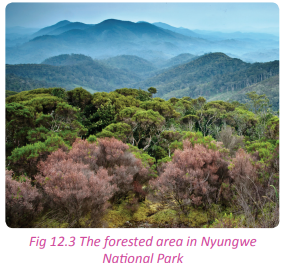 (b) Artificial forests
(b) Artificial forests These types of forests are very common
along the slopes of the hilly areas of
Rwanda.
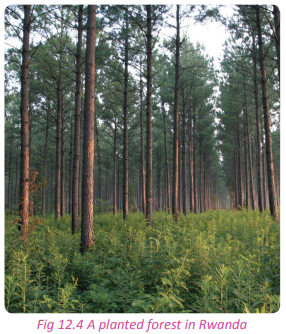 Natural forests of Rwanda
(a) Nyungwe Forest
Natural forests of Rwanda
(a) Nyungwe Forest
Nyungwe Forest is a high-altitude,
montane
tropical rainforest that is situated in the
Southwestern part of Rwanda. It borders
Burundi to the south. The forest is the
largest mountain rainforest in East and
Central Africa. It contains over 13 different
species of
primates.
It is one of the wellpreserved and protected
montane forests
in Africa.
The location of Nyungwe Forest places it
between the watershed of the basin of the
River Congo to the west and the basin of
the River Nile to the east. The eastern part
of the forest is believed to be the source of
the Nile.
Nyungwe Forest was established as a
mountain reserve in 1933. It attained a
National Park status in 2004. The forest
covers an area of approximately 970 km²
of rain forest, bamboo, grassland, swamps
and bogs. The nearest town is Rusizi which
is 54 km to the west of the forest.
Characteristics of Nyungwe Forest
(a) It is the largest montane forest in East
and Central Africa.
(b) It has a very rich
biodiversity with a
variety of flora and fauna.
(c) It has more than 200 species of trees
and a wide range of flowering plants.
(d) It is located on a rugged terrain.
(e) It receives heavy rainfall throughout
the year.
(f) Nyungwe Forest experiences a
temperature range that is between
00
-300
C with an average temperature
of about 15.50
C.
(g) It experiences two climatic seasons.

There are marshy areas in the lowland
areas of the forest.
(i) It has a large canopy that limits
sunshine from reaching the forest
floor.
(j) It has little undergrowth due to little
or no sunlight reaching the ground.
(k) It has evergreen vegetation.
(l) The trees and other plants have broad
leaves.
(m) The trees grow tall to about 30-50
metres high.

The forest produces hard woods.
(o) There is a wide variety of creeping
plants.
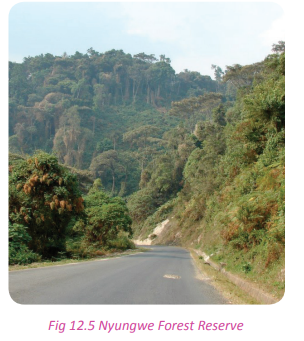 (b) Gishwati Forest
(b) Gishwati Forest This is the second largest indigenous forest
in the country. Currently, it is a protected
area. Gishwati Forest is located to the
northwestern part of Rwanda. It is found in
the Western Province.
Characteristics of Gishwati Forest
(a) It has various tree and shrub species
with a wide variety of indigenous hard
woods and bamboo trees.
(b) The trees in the forest grow very tall.
(c) It is located on an altitude of about
2669 metres above sea level.
(d) It occupies part of the Congo-Nile
divide and the Albertine Rift.
(e) Gishwati Forest is a protected area.
(f) It suffered serious deforestation in the
past 50 years.
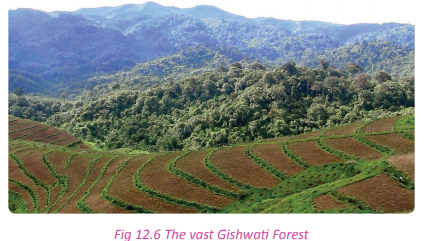 (c) Mukura Forest
(c) Mukura Forest
This forest is located in the north-west
part of Rwanda. It covers an area of about
12 km
2
. It is the smallest forested area in
Rwanda. It used to be connected to the
Gishwati and Nyungwe Forests in the past.
However, due to intense deforestation the
three were disconnected. A big part of
the forest was destroyed. This caused the
destruction of its biodiversity.
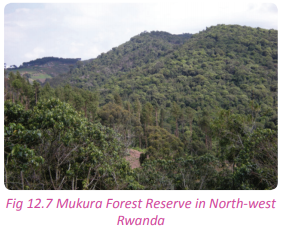 Characteristics of Mukura Forest
Characteristics of Mukura Forest(a) The forest is located on an elevation
of about 2600 metres above sea level.
(b) It has scattered trees towards the
edges of the forest.
(c) The forest experiences an annual
temperature of 15°C.
(d) It is located in the western side of the
Congo Nile crest.
(e) It receives annual rainfall total of about
1500mm.
(d) Birunga Forest
The Birunga Forest is found in the Northern
Province, in Musanze district of Rwanda. It is
located near the volcanic mountains found
in the area. It is home to the mountain
gorillas. It has a wide variety of tree species
and other vegetation.
The forest covers a land area of 7,800 km
2
The characteristics of Birunga Forest
(a) It has a wide range of biodiversity.
(b) The forest contains two of the world’s
most active volcanoes.
(c) Mountain gorillas live in the forest.
(d) The forest is also home to about 258
different species of birds.
(e) The vegetation types of the Birunga
Volcanoes are diverse and vary with
altitude.
(f) The forest is thick with different tree
This is a small forest located in the Western
Province of Rwanda in Nyamasheke district,
Nkungu sector near Nyakabuye town close
to the border with Democratic Republic
of Congo. It is located on a high elevation
area that is about 1924 metres above the
sea level.
Characteristics of Cyamudongo Forest (a) The forest has a dense canopy that
hardly allows the penetration of the
sun-light to reach the forest ground.
(b) There is dense vegetation with little
undergrowth.
(c) The forest has a wide range of tree
species.
(d) It has many climbing trees.
(e) The trees are very tall.
(e) Cyamudongo Forest
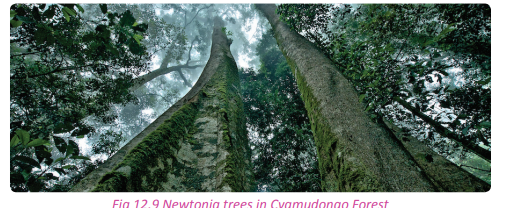 (f) Akagera Forest
(f) Akagera Forest
The Akagera Forest is located in the Eastern
Province of Rwanda, in Nyagatare and
Gatsibo districts. This forest is a conserved
area and one of the national parks in the
country. It has a variety of trees and wild
animals that attract thousands of tourists.
Characteristics of the Akagera Forest (a) The forest has deciduous trees. The
trees shed their leaves to reduce
transpiration because of drought.
(b) The trees in the forest have thick barks
to keep moisture.
(c) There are hardwood tree species in it.
(d) Trees are averagely short and tend to
grow to between 0 –12 metres in height.
(e) The trees have Y-shaped branches.
(f) Valuable tree species are scattered.
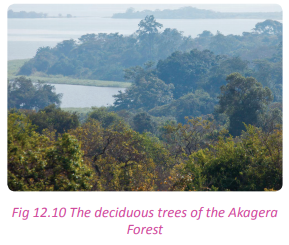 Artificial forests of Rwanda
Artificial forests of Rwanda
Activity 12.3
Work in pairs.
Study the photographs provided below
and use them to answer the questions that
follow.
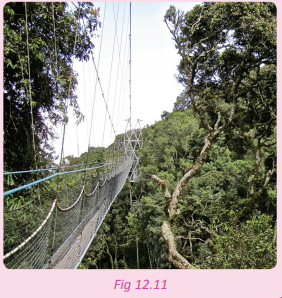
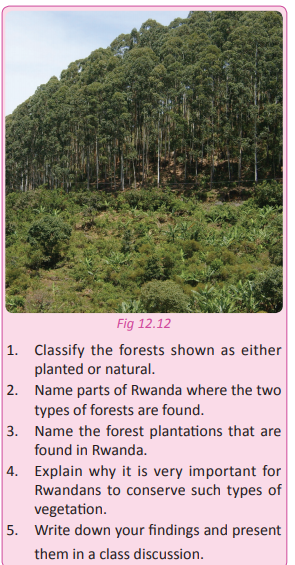
Artificial forests are planted by humans.
They include; forests on Mount Kigali and
the Arboretum of Ruhande in Huye district.
Task 12.1
1. Name the natural forests in Rwanda.
2. (a) Define an artificial forests.
(b) Give examples of the artificial
forests found in Rwanda.
3. Outline the distinct characteristics of
Cyamudongo Forest.
Factors influencing forest
exploitation
Case study
John Richards is a European who decided
to spend his summer holidays in Rwanda.
While in the country, he visited various
areas. He was very pleased by what he saw.
He wrote this down in his note book:
Rwanda is a country that is so rich with flora
and fauna. The country’s geography is wellbalanced. Its climate is good. The drainage
is good and the infrastructure is well
developed. The Eastern Province is made
up of savanna grasslands with the beautiful
bushes and thickets in Akagera National
Park. The northern region beautifully rolls
with hills and mountains that are covered
by evergreen trees. The forests offer a home
to the endangered mountain gorillas. The
Nyungwe Forest has tall trees that almost
reach the heavens. The wonderful canopy
walk was a great experience. Rwanda’s
people are warm and very hardworking.
There is a lot of potential for exploitation in
the forests of this green land of a thousand
hills. I will definitely come back here.
(a) Account for the variation of the plant
cover of Rwanda witnessed by John.
(b) Identify the forested areas that are
mentioned in the story.
(c) Name the forest resources that are
available for exploitation.
(d) Explain the factors that influence the
exploitation of forests that have been
mentioned by Mr. Richards.
(e) Evaluate the importance of forest
resources to the country of Rwanda.
(f) Present your findings in a class
discussion.
Forest exploitation refers to the careful,
planned and well managed harvesting of
trees in forests for the utilisation of timber,
wood fuel, medicinal plants and other forest
products.
There are physical and human factors that
influence the exploitation of forests. They
include the following:
Physical factors
(a) Climate Areas in Rwanda that have evenly distributed
and reliable rainfall and moderate
temperatures favour the growth of forests
thus their exploitation. The Northern and
Western Provinces of the country are
densely forested due to the favourable
climate that is associated with the areas.
On the other hand, the unreliability of
rainfall and high temperatures in the Eastern
Province does not favour the growth of
trees that can yield timber.
(b) The relief of an area Relief refers to the general appearance of
the landscape of an area. Mountainous
areas in Rwanda especially those at 1000
metres above sea level have dense forests.
This is due to the occurrence of relief rainfall
which is abundant on the windward side of
the mountains. This factor has favoured the
forests in Musanze area where dense forests
are present. The landscape is however very
different in the Eastern part of the country
where there are lowlands, little rainfall and
scarce vegetation.
(c) Presence of humidity Areas with high humidity such as those near
lake shores experience convectional rainfall.
The rainfall
supports the growth of trees
that form forests.
(d) Presence of forests
Exploitation of forests depends on their
presence. In Rwanda, there are few forested
areas. The few forests that are there are
conservation areas and are thus protected.
(e) Tree species
There are limited tree species of high value
in most forested areas of Rwanda. The few
available are scattered and locating them is
difficult. This has created the need to plant
forests that have the tree species of high
value in order to meet the demands of the
timber industry in the country.
(f) Drainage
In some areas of the country, exploitation
of forests is affected by the marshy nature
of the valleys which are found in forests
such as in Nyungwe. Forests in such areas
are not easily accessible. Areas with good
drainage are easily accessible and support
the exploitation of forests such as in the
highlands of Gicumbi district.
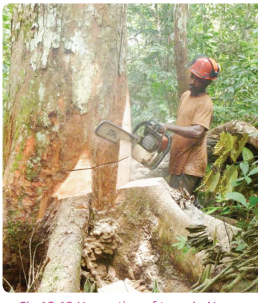 Human factors
(a) The availability and nature of the
labour force
Human factors
(a) The availability and nature of the
labour force The exploitation of forests in Rwanda is
widely affected by the scarcity of labour. This
greatly affects the sustainable utilisation of
forests and their resources.
(b) Availability of adequate capital
This factor is at the centre of forest
exploitation in Rwanda. Large amounts
of capital are required to purchase the in
puts and to pay the workers. Since there is
a scarcity of capital, exploitation of forests
is on a very small scale.
(c) Level of technology
The level of technology related to forest
exploitation in Rwanda is steadily improving.
Technology determines how much forest
resources are exploited and how they are
extracted. In places with less technology,
the exploitation is still crude and the yields
equally poor.
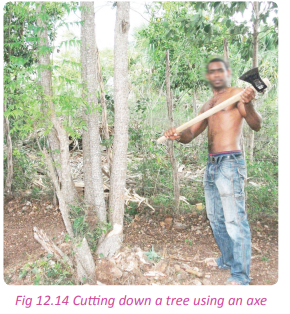 (d) Government policy
(d) Government policy
The government of Rwanda has developed
policies that aim at conserving and protecting
the forested areas. Through government
interventions and authorisation, forest
exploitation can only be done in a sustainable
manner.
(e) Transport and communication
Most of the forested areas in Rwanda are
located in rugged and heavily mountainous
areas. Accessing these areas and transporting
the already harvested trees is difficult. This
negatively affects forest exploitation.
(f) Availability of markets
There is a wide market for forest products in
Rwanda and its neighbouring countries. This
demand for timber and other forest products
encourages the exploitation of forests.
(g) Research
The government and private agencies have
conducted a number of research studies
to find appropriate ways of ensuring
sustainable utilisation of forested areas of
Rwanda. The research activities support
forest exploitation in a sustainable manner.
 Population levels
Population levels
The high and ever increasing population of
Rwanda creates the demand for timber and
other forest products thus influencing the
exploitation of forests.
(i) Political stability
The development and growth of the industry
is attributed to stability and security that
Rwanda enjoys. Exploitation of forests goes
on without fear since there is a relatively assured sense of security against criminals.
Lumbering/ forest exploitation in
Rwanda (methods of lumbering)
Activity 12.4
Your teacher will organise for you a field
study visit to one of the major forests in
Rwanda.
In groups of five find out;
1. The process of lumbering practiced in
the forest you have visited and in the
country at large.
2. Describe how each of the lumbering
methods is done.
3. The importance of lumbering in the
forest visited and in the country at
large.
4. Write down your findings and discuss
them in a class presentation.
Lumbering/ forest exploitation in
Rwanda (methods of lumbering)
Activity 12.4
Your teacher will organise for you a field
study visit to one of the major forests in
Rwanda.
In groups of five find out;
1. The process of lumbering practiced in
the forest you have visited and in the
country at large.
2. Describe how each of the lumbering
methods is done.
3. The importance of lumbering in the
forest visited and in the country at
large.
4. Write down your findings and discuss
them in a class presentation.
Lumbering refers to the act of extracting
timber and logs from the trees in a forest for
commercial purposes. The exploitation of
forests in Rwanda is strictly regulated due to
the significance the Rwandan government
and Rwandans themselves attach to the
forests. In the quest to conserve and
protect the environment, there are licensed
companies and cooperative societies that
are allowed to practice lumbering under
strict supervision by the government
agencies.
A majority of Rwandan citizens are only
involved in small scale lumbering. They
use simple machines like the hand saws
and axes.
The Process of lumbering in Rwanda
Activity 12.5
In groups, use the photograph provided
below to answer the questions that follow.
1. Discuss the lumbering methods used in
Rwanda.
2. Describe the activity that is taking place
in the photograph.
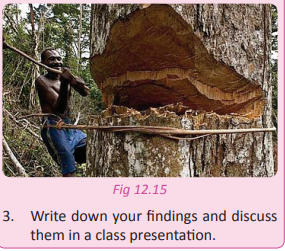
The methods of lumbering used in Rwanda
are discussed below.
(a) Identifying specific trees to be cut.
(b) Felling
This is concerned with the cutting down of
trees
(d) Yarding or dragging
This is the transportation of logs to a
collecting centre.
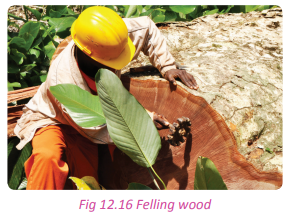
However, as a regulation by the Rwanda Bureau of Standards, it is mandatory that
workers put on protective clothing such as
brightly coloured helmets for protection
and detection.
(c) Bucking This is the cutting of the felled trees into logs
so as to enable transportation or extraction
of timber from them.
 (d) Yarding or dragging
(d) Yarding or dragging
This is the transportation of logs to a
collecting centre.
(e) Loading
The logs and timber are carried and loaded
onto trucks and taken to sawing mills and
furniture makers.
Task 12.2
1. Discuss the factors that influence forest
exploitation in Rwanda.
2. Explain the process of lumbering.
Importance of forests and forestry
in Rwanda
Case study
Read the following report extracted from
the Rwanda State of Environment and
Outlook Report chapter (vi). Use it to
answer the questions that follows.
Opportunities from the forest sector Forest ecosystems provide goods and
services such as wood for fuel and
construction, water catchment protection,
water purification, tourism, non-timber
forest products such as medicinal plants,
honey and materials for handicrafts.
The national economy At present, the contribution of the forestry
sector to the national economy remains
unknown and existing statistics from past
years underestimate the contribution of
the forestry sector to the national Gross
Domestic Product. However, in 1991,
the National Commission on Agriculture
reported that despite the importance of
forest plantations, their contribution to
the Gross Domestic Product as recorded in
the national accounting system was only
1.9 per cent in 1987. In the same vein, the
Food Security Strategy and Action Plan of
1997 points out that the total contribution
of agriculture to the Gross Domestic Product
was in the order of 36.6 per cent of which
silviculture represented only 0.6 per cent.
Energy
Wood remains the main source of domestic
energy for more than 90 per cent of
Rwandans. In 1997, wood fuel consumption was estimated to be at 7.1 million m3
of
wood. Approximately 5 per cent of this
volume was consumed by the small scale
industries. Charcoal is usually used in towns
and its annual production was estimated at
46,000 tons, 80 per cent of which were sold
in Kigali (MINAGRI 1998).
(a) Identify and explain the importance of
forests mentioned in the above report.
(b) Examine other positive contributions
of forests to Rwanda that are not
mentioned in the above extract.
(c) From your own knowledge and
observations of your local environment,
do you think forests are important?
Explain your answer.
(d) The government has invested a lot in
the conservation and protection of
forests. Justify this statement.
The following are some of the reasons
forests and forestry are important in
Rwanda.
(a) Employment opportunities Forestry offers employment opportunities
to people both directly and indirectly.
Examples of people employed in the sector
include loggers, foresters, rangers, technical
personnel and saw millers. Table 12.1 shows
the number of people employed in the
sector.
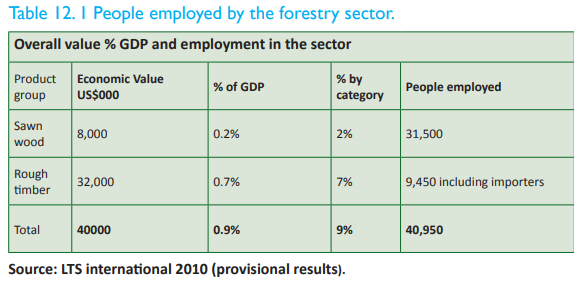 (b) Source of water catchment areas
(b) Source of water catchment areas Forested areas are also water catchment
areas. They are sources of most of the rivers
in the country. For example, the Akagera
River has its catchment in the Nyungwe
Forest. Forests further provide the water
purification systems hence enabling the
availability of clean and safe water for use.
(c) Raw materials
There are a number of raw materials
that are obtained from the forests. They
include poles and timber that are needed
in the furniture making industry and the
construction sector. Other materials used
in art, craft and medicine are also obtained
from forests.
(d) Protection of soil against erosion Forests hold the soils together making them
strong enough to resist erosion. Erosion
causes soil degradation and a reduction in
soil fertility. The tree branches absorb the
force of the pounding raindrops and hence
reduce the occurrence of splash erosion.
(e) Source of revenue to the government Many people and companies that are
involved in forest exploitation pay taxes
to the government. The revenue collected
supplements other government’s sources
of revenue that are used to develop other
sectors of the economy.
(f) Home for wildlife
There is a wide variety of flora and fauna
that are found in forested areas. Forests
support a host of biodiversity. Different
plant and animal species are found in the
forests.
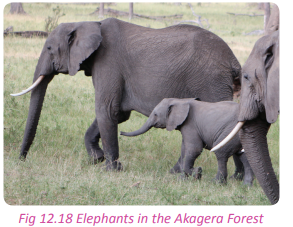 (g) Source of medicine
(g) Source of medicine
Forests have trees, shrubs and other
vegetation that are traditionally used as
medicine. Other herbs are used in the
manufacture of conventional medicine such
as quinine, which is used in the treatment
of malaria.
 Foreign exchange
Foreign exchange
Though not many forest products are
exported, the few that are sold outside
Rwanda, such as furniture, enable the
government to earn foreign exchange.
(i) Tourist attraction
The economy of Rwanda is greatly supported
by tourism. The forests, the birds and the
wild animals in them are all tourist attraction
sites. Tourists bring foreign exchange to the
country and also facilitate the development
of other infrastructure like hotels, lodgings,
roads, air transport facilities.
(j) Research and studies Forests assist students and other researchers to
conduct various studies on forests and forestry.
Learners in higher institutions frequently carry
out fieldwork in forested areas.
(k) Art and craft There are many art and craft items that are
made in Rwanda. The raw materials used
are obtained from the forests. For example,
wood carving entirely depends on the wood
obtained from forests. Some of these art
and craft items are part of the Rwandan
culture.
 (l) Modification of climate
(l) Modification of climate
To a great extent, forests are responsible for
the climate of the areas in which they are
found. The role of forests in the hydrological
cycle and in the cleaning of the atmosphere
is very key.
(m) Source of food
There is a wide variety of fruits and vegetables
that grow wildly in forested areas. They
supplement the food requirements of
humans.
Products from lumbering in
Rwanda
Activity 12.6
Work in pairs.
1. Define lumbering.
2. Name some of the areas in Rwanda
where lumbering takes place.
3. Identify the products obtained from
forests that are used in your school.
4. Other than the products identified in (3)
above, identify other products obtained
from lumbering in Rwanda.
5. Write down your findings and discuss
your work in a class presentation.
Below are the some of the products that are
obtained from lumbering in Rwanda:
• Timber (lumber)
• Poles used for fencing, building and
telecommunication and electricity
• Sawn wood
• Plywood
• Veneers
• Particle board
• Fibreboards
• Fuel wood (firewood and charcoal)
The above products are used to create other
products. Below are some examples of the
items that are made out from lumbering
products.
• Construction or building materials.
• Furniture items.
• Bridges.
• Boats.
• Musical instruments such as violin, guitar.
• Sports equipment (hockey sticks, tennis
bats).
• Used in flooring houses in the form of
tiles.
• Fences.
• Art and craft to make decorative items
such as carvings.
Problems affecting the forest
exploitation/lumbering in Rwanda
Activity 12.7 Work in pairs.
Using the Internet and knowledge obtained
by observing your local environment;
1. Find out the challenges that affect
forest exploitation in Rwanda.
2. Suggest the solutions or control
measures that can be put in place to
deal with the challenges identified.
3. Write down your answers and share
them in a class presentation.
There are a number of problems that affect
forest exploitation in Rwanda. They are
discussed below.
(a) Poor technology
The exploitation of forests in Rwanda
is still carried out by people who use
simple tools such as hand saws and axes.
The output of this hardly meets the ever
increasing demand for forest products. Poor
technology therefore translates to the use
of poor equipment and hence poor output.
(b) Inadequate skilled workforce
There is a general lack of professionals
in the lumbering and wood processing
sectors. The use of unskilled workers has
contributed to the waste of forest resources
and production of substandard products.
(c) Reduced forest resources
The forestry sector is threatened by the
increasing demand for wood and its
products. This has left many forested
areas bare. The population of Rwanda is
increasing. Due to its rural nature, with
people earning low incomes, they only use
wood as the source of energy. The people
also clear forested areas to create space
for settlements. The end result of this has
been reduced forests and their resources.
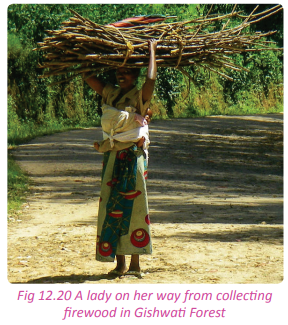 (d) High demand for wood products
(d) High demand for wood products This has come as a result of the increasing
population which has put pressure on forest
resources. The wood products are needed in
the construction of buildings and furniture
making industry.
(e) Mismanagement of forest plantations
Forest managers have mismanaged the
forests by failing to regulate the rate at
which trees are harvested against their
replacement. This happens a lot in the
planted or artificial forests, which are the
main source of wood.
(f) Poor grading and treatment standards This is a serious problem that affects
lumbering and forest exploitation in
Rwanda. The parties involved in forest
exploitation have limited knowledge on how
they can add value to their products. This
makes their products substandard.
(g) Poor statistical data related to wood
production
Forest exploitation in Rwanda is supported
by the private forest plantations that are
owned by individuals and private timber
dealers. Most of them do not keep records
of their operations due to lack of both
entrepreneurial and scientific knowledge
and skills. This has been an obstacle to the
planning and monitoring systems of the
country with regards to forestry.
 Fire outbreaks
Fire outbreaks
There are frequent fire outbreaks that have
always claimed large hectares of forested
lands especially in the Akagera National
Park and in the private forest plantations in
Gicumbi. These leave behind the trees that
are stunted and of poor quality. This mostly
occurs during the dry season.
(i) The need to develop tourism Since most of the natural forests in Rwanda
are under protected areas, they are regarded
as tourist attraction sites. Sometimes the
tourists erect tents inside the forests in the
process destroying young immature trees.
At other times, they cause forest fires.
(j) Animals, pests and disease destruction
Wild animals such as monkeys sometimes
destroy young trees. The high population of
animals such as buffaloes in national parks
threatens the trees in the forests. During
the dry season, they overgraze and end up
feeding on young trees thus destroying the
forests. Pests like caterpillars and termites
destroy the leaves and barks of trees
creating defects in the wood. At other times,
diseases attack the trees drying them before
they mature.
(k) Long maturity periods
Most of the indigenous tree species that
yield hard wood take too long to mature.
This makes it difficult for people to plant
them since they prefer growing trees that
mature quickly and can be harvested as
fast as possible.
(l) Competition There is high competition from other wood
producing countries. The most competitive
wood and wood products come from the
DRC. The wood from there is hard and of
good quality. It is therefore better than
the locally produced wood in Rwanda.
This reduces the demand for local wood
processed by the lumbering sector of
Rwanda, affecting the local businesses.
(m) Inadequate capital There is a shortage of the required capital to
be used in developing the wood extraction
and forestry industry. Most of the people
engaged in forest exploitation are middle
and low income earners who do not have
much capital to offer.
 Poor transport and communication
facilities
Poor transport and communication
facilities
The forested areas and forest plantations
are located in areas where roads are poorly
developed and impassable during the rainy
season. In some parts, roads do not exist
at all especially in rural areas. Where roads
are better, the operators are faced with lack
of suitable trucks designed to carry and
transport timber.
Task 12.3
1. Discuss the importance of forests in
Rwanda.
2. Highlight five problems that effect
forest exploitation in Rwanda.
Deforestation
Activity 12.8
Work in pairs.
Study the following photograph provided
and use it to answer the questions that
follow.
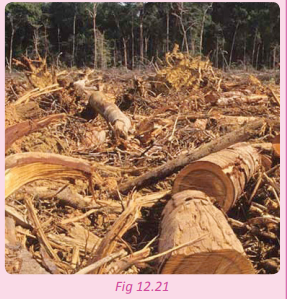
1. Describe what is happening in the
picture shown.
2. Give reasons why people cut down
trees in Rwanda.
3. What are some of the effects of cutting
down trees to the country?
4. Relate the situation shown in the
picture with other areas in Rwanda.
5. Suggest conservation measures that can
be observed to ensure that the trees in
the forested areas are conserved.
6. Discuss the importance of conserving
forests.
7. Present your findings in a class
presentation.
Deforestation is the permanent destruction
of forests in order to make the land available
for other uses. Deforestation is a problem in
some parts of Rwanda. These parts include
Gicumbi, the area around the Akagera
National Park and other areas situated along
the slopes of the hilly parts of the country.
Causes of deforestation
(a) Increased populationRwanda has always had a population
increase since independence. This increase
has led to the high demand for land for
settlement, agriculture and firewood. This
need has left many parts of the forests
stripped, hence deforested.
(b) Bush burning
Bush burning has claimed many parts of the
forests in the country. The fires are sometimes
caused by the locals, tourists or accidents.
(c) Charcoal burning
This practice has caused serious
deforestation in areas of Gicumbi, Eastern
and Southern Provinces. The steep slopes
are stripped of the trees leaving the soils
bare. In the process of burning charcoal,
bush fires may be caused.
(d) Poor farming methods Although the government has played a great
role in assisting the farmers transform their
agricultural practices, some farmers still
stick to their old traditional practices. For
example, the farmers who stay near the
natural forests such as the Akagera and
Mukura Forests, still cut trees and burn
vegetation in order to prepare their fields
for the next planting season.
(e) Road and infrastructual development
There is massive development of various
infrastructure in Rwanda. This has cost the
country a huge number of trees as sites
have to be prepared for the construction of
schools, roads and hospitals. For example,
the road constructed through Nyungwe
Forest caused serious deforestation.
(f) Overgrazing In areas where cattle keeping is still
characterised by large herds of animals,
the cattle overgraze in a limited area. During
the dry season, the livestock feed on young
trees leading to deforestation.
(g) High demand for forest products
There is a need for harvesting trees in forests
for products such as timber and poles that
are required in the making of furniture
items and other commercial products. This
demand leads to deforestation.
 Urbanisation
UrbanisationThis has created the need for more land for
the construction and expansion of urban
centres as they struggle to implement
their master plans. This leads to clearing of
forested areas and forest plantations that
are near urban centres.
(i) Landslides and mass wasting
This has caused deforestation in various
areas of Rwanda. During the rainy season
the slopes are affected by mass wasting
and the landslides. As the soils break off,
the trees and vegetation on the slopes fall
away too and get destroyed.
(j) Mining
Mining has also caused deforestation in
many parts of Nyungwe Forest. Trees are cleared as the soils are dug up to create
mining sites.
(k) Climatic changes
Harsh climatic conditions occur as a result
of deforestation. Ironically, the harsh
conditions cause further deforestation by
drying up young and immature trees. This
is a common occurrence in the Eastern
Province where during the dry season, many
trees dry up.
(l) Biotic factorsTermites and many other wild animals such
as elephants destroy many trees. Bugesera
area has had a serious problem with the
termites which eat up trees during the dry
season. Nyungwe and Akagera National
Parks have also lost many trees due to
destruction by wild animals, hence causing
deforestation.
Effects of deforestation in Rwanda
Activity 12.9
Work in pairs.
1. Uwamaliya Gloriose advised her
learners never to cut trees without
planting more than what they cut. She
further told them that global warming
is as a result of deforestation and poor
environmental management.
2. A part from the effect mentioned in
the statement said by the teacher in
(1) above, what are the other effects
of deforestation?
3. Explain why this teacher was concerned
with conserving forests.
4. Write down your answers and discuss
them in a class presentation.
Deforestation affects the climate and the
environment which in turn affects the
well being of humans. Some of the effects
of deforestation in Rwanda include the
following:
(a) Global warming Cutting down trees interrupts the global
carbon cycle. The carbon dioxide in the air
is greatly harvested by trees which store
it. Global warming has increased because
the forests and vegetation cover have been
cleared.
(b) Air pollution
The carbon dioxide released into the
atmosphere pollutes the air. Due to lack of
forests, the carbon dioxide is not absorbed
and therefore stays on in the atmosphere
further polluting the air.
(c) Interference with the hydrological
cycle Deforestation leaves large quantities of trees
cut. This interferes with the hydrological
cycle. Trees absorb the rain water that
infiltrates into the soils and loses it through
evapotranspiration. This enables the water
to go back into the atmosphere condensing
and falling as rain again. This explains why
deforestation leads to absence or reduction
of rainfall in an area.
(d) Loss of valuable tree species
The clearance of trees and other vegetation
when felling trees has led to disappearance
of some species of both flora and fauna.
It is important to note that 70% of fauna
and flora are found in forested areas.
Clearing them puts some of them at a risk
of extinction.
(e) Severe soil erosion
Trees play a great role in binding the soils
together thus reducing the impact of soil
erosion. Some tree branches also break the
force of falling raindrops hence reducing
erosion. When trees are cut, the soils are
left bare and exposed to agents of erosion.
Erosion degrades the soil by reducing its
fertility and productivity.
(f) Reduction of the natural evaporation
cooling system The clearing and cutting of forested areas
has limited the effectiveness of the natural
evaporation cooling system. This system
naturally regulates the temperatures in the
areas where evaporation takes place. The
moisture found above the ground within the
canopies of trees protects the ground from
the in-coming sun’s rays by creating cool
air. When the trees are cut, the air heats
up and this has effects on the eco-system
within the area.
(g) Acidification of water bodies
The excess carbon dioxide in the atmosphere
due to lack of trees is eventually absorbed
by water bodies. This acidifies the water
making it unfit for human consumption.
 Negative effects on the quality of life
Negative effects on the quality of life Deforestation exposes soils to the agents
of erosion. The top soils are washed and
deposited into the rivers and lakes. This
pollutes the water making it unfit for human
consumption.
(i) Increased government expenditure
The government spends a lot of money
dealing with the effects of deforestation.
For example, billions of francs are spent
in constructing terraces in areas where
soil erosion is a problem as a result of
deforestation. These funds would be used
to develop other sectors of the economy.
(j) Imbalance in the eco-system Deforestation causes an imbalance in the
ecosystem in the areas were it occurs.
For example, the silt deposited into water
bodies threatens the aquatic animals.
(k) Floods
Deforestation leads to severe soil erosion.
The river channels are made shallow thus
reducing their capacity. When the water
volume increases, it ends up causing floods.
The floods have negative effects on humans,
animals and the environment.
Task 12.4
1. Define deforestation.
2. Give two effects of deforestation in
Rwanda.
Forest conservation and the management (policy measures) in
Rwanda
Case studyRead the newspaper extract provided below and answer the questions that follow.

punishments that range from six months to three years,” he said. All the 13 suspects are
expected to appear before the court today.
(a) From the newspaper extract, point out the measures put in place by the government
of Rwanda to prevent illegal exploitation of trees and to conserve forests.
(b) Apart from the legal actions taken against those who cause deforestation, suggest
other measures that the leaders in the above district should take to solve the problem.
(c) Do you think forest conservation and management is important in Rwanda?
(d) Write down your findings and present them in a class discussion.
Forest conservation is the practice of
planning and maintaining forested areas
for the benefit and sustainability of future
generations.
Forest management is concerned with the
administrative, economic, legal and social
aspects of forest protection and regulation.
It mainly aims at maintaining the quality and
standards of the forests.
Rwanda has joined other nations of the
world to address the issues concerning
conservation and management of forests.
The government of Rwanda is a signatory
member of the Kyoto Protocol, Convention
on Biological Diversity, Convention on
International Trade in Endangered Species
CITES and the United Nations Framework
Convention on Climate Change. All these
have contributed to the conservation and
management of forests and the environment
of Rwanda. Their contributions have been
through the provision of funds, technical
personnel and sharing of research findings.
Locally, Rwanda has carried out various
campaign programmes aimed at conserving
and managing the forests of the country.
The programs aim at enabling sustainable
utilisation of forests and forest resources.
The government has enacted laws and
established guidelines on forest conservation
and management in the country. It has also
come up with other non-legal measures
that are aimed at conserving and managing
forests. The measures include the following:
(a) Establishment of conservation and
protected forested areas
The government of Rwanda passed a law
No. 47/1988 of 5/12/1988 on the protection
of forests. This law makes it illegal to cut
trees from the protected forested areas.
(b) Reforestation
This is the planting of trees in areas that
were once forested but were deforested.
This practice is currently at the centre of
forest conservation and management in
Rwanda. The government encourages the
planting of trees and has even set aside
specific days for tree planting.
(c) Afforestation
This is the establishment of forests or tree
stands in areas where there was none
before. Currently, in Rwanda, trees are being
planted in areas where they never existed
before. This practice has increased the
coverage area of forests in country.
(d) Introduction of improved tree species
The traditional eucalyptus trees are now
being replaced with improved tree species
that mature quickly and are able to yield
better quality wood. The tree species
include acacia mearnsii, acacia melanoxylon
and a variety of modern eucalyptus trees
of good species which include, Eucalyptus
maidenii and Eucalyptus grandis.
(e) Agroforestry
The government of Rwanda through its
agencies together with non-governmental
organisations encourage its citizens to grow
crops and trees at the same time. This is
done to address the need of increasing the
tree cover and to reduce the threatening
risk of desertification especially in the
Eastern Province.
(f) Strengthening institutions concerned
with forestry
The government has provided full support
to the Ministry of Forests and Natural
Resources and the National Forestry
Authority. These institutions are active at
the grassroot levels. The institutions have
qualified personnel whose role is to ensure
that forests are protected , conserved and
well managed. There is also rigorous mass
education on the importance of forest
conservation and management.
(g) Improved lumbering methods The government encourages the people
engaged in exploitation of forest resources
to use better and improved tree felling
methods.
 Reduction of wastage
Reduction of wastage The processing industries involved in
furniture and saw milling are encouraged to
utilise all the wood resources to minimise
wastage of wood products.
(i) Alternative sources of fuel
The government encourages its citizens
to use alternatives sources of fuel such
as biogas, solar energy and hydroelectric
power. This will reduce the pressure put
on the forest products especially firewood.
(j) Intensive research
The government has invested a lot of
resources in research in relation to forests.
The researches are aimed at solving the
problems that affect forests and to improve
forest conservation and management.
(k) Development of human resources
The government of Rwanda has embarked
on training foresters in order to equip
them with all the required skills in forest
conservation and management. They are
given the technical and professional training
so as to ensure that the forest resources are
used sustainably.
(l) Restricting the use of poles and timber in
the construction industry
In 2003, the government passed a law
restricting the use of timber poles in
construction work. This was aimed at
reducing the demand for forest products.
The use of timber poles was to be replaced
with the use of metallic bars. This has
greatly assisted in decreasing the pressure
on forest resources that was threatening to
get out of hand.
Case study
Nyungwe Forest
Nyungwe Forest is one of the protected
natural forests of Rwanda. It is situated
in the south-western part of Rwanda.
It neighbours Burundi. It is one of the
successfully protected montane rainforests
in East and Central Africa. It is located in the
watershed between the basin of the river
Congo to the west and the basin of the river
Nile to the east. The source of river Nile is on
from the east side of the Nyungwe Forest.
The Nyungwe Forest was established as a
National Park in 2004. It covers a total area
of about 970 km2
of rainforest, bamboo,
grasslands, swamps and bogs. According
to the report from the Rwanda Office of
Tourism, the forest has more than 250
species of trees and shrubs and a wide
variety of birds and wild animals. This
makes Nyungwe one of the forests with
an enriched biodiversity in the region. It is
therefore a priority for conservation in Africa.
The park contains 13 different primate
species (25% of Africa’s total), 275 bird
species, 1068 plant species, 85 mammal
species and 38 reptile species. Many of
these animals are restricted-range species
that are only found in the Albertine Rift
montane forests eco-region in Africa. The
forest is at an altitude of 3000 metres above
sea level.
Nyungwe Forest is faced with a number of
challenges. There is illegal lumbering that
takes place in the forest and destruction of
vegetation.
The local beekeepers have their bee hives
in the forests. However, during the dry
season when honey is harvested, there are a lot of forest fires which burn many trees,
threatening to destroy the forest
According to a Rwanda Environmental
Management Authority(REMA) report,
there is serious deforestation in the buffer
zones of Nyungwe Forest. There is also
illegal charcoal burning that has seriously
affected the eco-system thus creating an
imbalance in the biodiversity of the forest.
Nyungwe Forest as a national park remains
the most cherished natural resource of
Rwanda. It must be protected.
Activity 12.10 Your teacher will take you on a field visit
to one of the forested areas in Rwanda.
In groups of five;
1. Observe the forest exploitation activities
that are carried out in the forest.
2. Record your observations.
3. Discuss your observations in your
groups referring to the knowledge on
forestry and forest exploitation that you
have acquired.
4. Write a report of your findings for a
class presentation.
Did you know? • Half of all the biodiversity in subSaharan Africa can be found in the
Birunga Forest.
• About a third of the world’s
approximately 800 remaining
mountain gorillas live in Rwanda.
• The Volcanoes National Park is one of
Africa’s oldest parks, established to
protect the mountain gorilla.
• Rwanda’s forests contain 39 million
metric tonnes of carbon in living forest
biomass.
• Rwanda envisions to have a 30% forest
cover by 2020.
End of unit revision task
1. (a) Name any two natural forests of
Rwanda.
(b) Assess the contribution of any of the
forests mentioned in (a) above to the
economic development of Rwanda.
2. (a) Differentiate between forest
conservation and forest management.
(b) Describe the forest conservation and
management measures put in place by
the government of Rwanda to ensure
sustainable utilisation of her forest
resources.
3. To what extent have the physical
factors influenced forest exploitation
in Rwanda?
4. (a) With the help of a sketch map of
Rwanda, identify and locate the
forested areas.
(b) Examine the problems affecting forest
exploitation in Rwanda.
5. (a) Define lumbering.
(b) Name areas in Rwanda where
lumbering takes place.
(c) Mention the products of lumbering in
Rwanda.
6. (a) Assess the causes and effects of
deforestation in Rwanda.
(b) Suggest measures taken by the
Rwandan government to ensure
conservation and management of the
forests in the country.
There are marshy areas in the lowland areas of the forest.
The forest produces hard woods.
Population levels
Foreign exchange
Fire outbreaks
Poor transport and communication facilities
Urbanisation
Negative effects on the quality of life
Reduction of wastage
